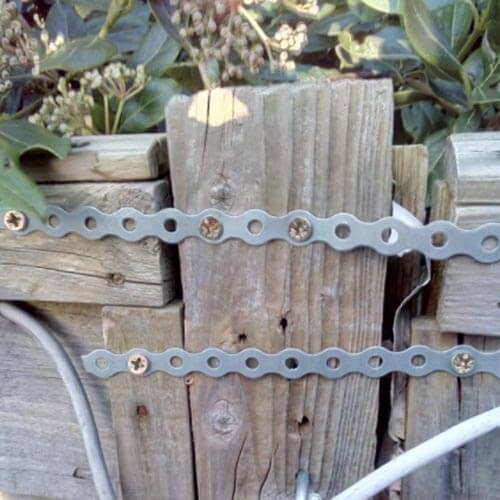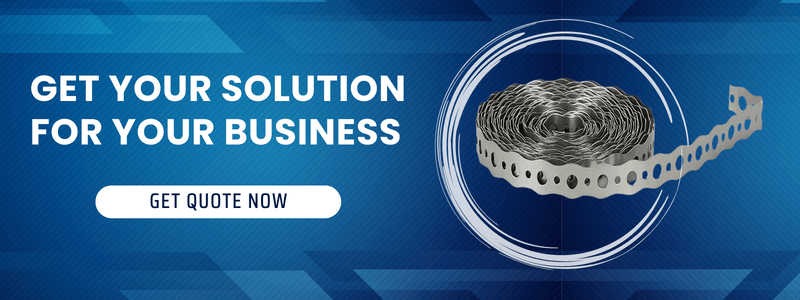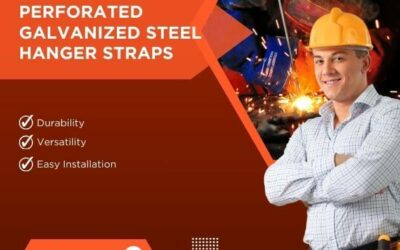Perforated steel banding, also known as perforated band or wavy perforated bands, refers to thin metal strips with holes punched in them at regular intervals. This versatile product has numerous applications in construction, packaging, and more. In this comprehensive guide, we’ll explore everything you need to know about perforated steel bands.

How Perforated Steel Bands Are Made
Perforated steel bands are made from cold rolled steel sheets that undergo a punching process. The sheets are first slit into desired widths, then fed through a machine called a perforator. This device uses a punch and die set to cut evenly spaced holes into the steel ribbon.
The size and spacing of the holes can vary depending on the desired flexibility and strength of the final product. Smaller holes typically allow for more flexibility, while larger holes provide greater strength. Standard hole sizes range from 0.1 inches to 0.5 inches.
After perforating, the steel strips may go through additional processes like degreasing, painting, galvanizing, or adding other coatings to prevent corrosion and rust. The finished perforated bands are then wound onto coils or cut into straight lengths for shipping and use.
Key Properties and Advantages of Perforated Bands
There are several notable properties and advantages that make perforated steel bands useful across many applications:
Flexibility
The holes punched into the steel allow the bands to flex and curve easily without cracking or breaking. This high flexibility enables wrapping and securing objects with tight, clean bends.
Breathability
The perforations allow for airflow and ventilation. This makes the bands suitable for wrapping items that require breathing room like produce, flowers, and more.
Lightweight Strength
Despite being lightweight, perforated bands maintain good tensile strength to securely bind, unite, and reinforce items. The holes remove only small amounts of material so strength loss is minimized.
Customizable
Perforated bands can be customized with different hole sizes, spacings, and layouts to meet specific needs. Galvanizing and coatings also allow corrosion control for different environments.
Cost-Effective
Providing advantages like strength, breathability, and flexibility at low cost, perforated bands deliver excellent value for many applications. Less material is used compared to solid steel bands.
Applications and Uses of Perforated Steel Bands
Thanks to their well-balanced properties, perforated steel bands have diverse uses across many industries:
Construction
- Binding rebar and steel frames
- Securing wiring, ductwork, and plumbing pipes
- Attaching exterior siding and roofing materials
Packaging
- Strapping boxes, crates, and pallets
- Bundling produce, flowers, and other breathable items
- Sealing delivery packages
Industrial
- Holding parts, tools, and materials on racks and lines
- Attaching tags, signs, and notices in factories and warehouses
- Confining insulation on pipes, tanks, and equipment
Crafts
- Making decorative accents and ribbons
- Forming wreaths, rings, and sculptures
- Binding dried flowers and potpourri
Agriculture
- Supporting and training crops and tree branches
- Securing fencing and anti-bird netting
- Bundling hay, straw, and animal feed
As you can see, perforated banding has broad usefulness across many contexts. The next sections delve into the specific subtypes and styles available.

Types of Perforated Steel Bands
There are a few main categories of perforated bands defined by their distinct physical forms and features:
1. Flat Perforated Band
This refers to flat steel strip with punched holes. It maintains the straight, untwisted shape of the original steel coil. The rectangular cross-section and flat profile make it suitable for binding and uniting flat items. It can also easily wrap around rounded objects like poles or pipes.
2. Wavy Perforated Band
Wavy band has a zig-zag profile and undulating form. The wavy pattern provides flexibility while the peaks give grip and friction for holding items in place. The wavy shape also adds unique visual interest. It is commonly used in crafting, decor, and merchandising displays.
3. Twisted Perforated Band
Twisted band is made by twisting flat perforated steel strip at an angle during manufacturing. This gives the band excellent flexibility and conformability to wrap around irregular shapes. It also provides high gripping power for securing smooth cylindrical objects.
Finishes, Coatings, and Hardware
To expand their versatility and durability, perforated bands can come with different finishes and accessories:
Finishes
- Plain steel – unfinished perforated steel without any coating. Prone to corrosion if unprotected.
- Galvanized – zinc coating applied to steel surface for corrosion resistance. Most common finish.
- Painted/varnished – colored paint or varnish layers protect against corrosion while providing aesthetic options.
- Plastisol – plasticized PVC coating for very high corrosion and chemical resistance. Popular for acidic, caustic environments.
Accessories
- Buckles – allow for tightening and tensioning bands for adjustable and secure fastening. Common types are clip buckles, loop buckles, and self-locking buckles.
- Seals – crimped metal seals help fix band ends together for permanent securing and tamper-proofing.
- Tools – tensioners/strapping tools are available to dispense, tension, seal, and cut bands with ergonomic efficiency.
How to Select the Right Perforated Band
With the wide range of sizes, types, and features available, choosing the right perforated band requires matching specifications to your particular needs:
- Application – consider if you need light binding, heavy duty fastening, decorative flair, or other specific functions. This will guide your selection.
- Size – determine the dimensions of what you are wrapping or bundling. Measure circumference, length, and thickness to pick an appropriate band width and thickness.
- Flexibility – assess if you need to wrap small diameters, irregular shapes, or make sharp bends. More flexibility requires smaller holes, thinner material, and wavy or twisted forms.
- Strength – gauge the tension force needed and if there are safety concerns. Thicker-gauge steel and smaller perforations provide greater strength.
- Environment – if exposed to moisture, acids, chemicals, or UV light, ensure correct protective finish and corrosion resistance.
- Budget – less expensive options include plain steel, larger holes, lower gauges. More costly choices are stainless steel, smaller holes, and heavy thicknesses.
By carefully considering these factors, you can select perforated bands optimized for your specific use case. Test samples are also helpful to evaluate different options.
Perforated Banding Safety Tips
When handling and installing perforated bands, following basic safety measures will prevent possible hazards:
- Wear sturdy gloves to avoid hand lacerations from sharp band edges and ends.
- Use band tensioners/tools for dispensing to avoid dangerous recoil of tightly coiled bands.
- Follow recommended practices to tension bands sufficiently but not excessively to prevent breakage failures.
- Wear eye protection in case bands spring loose under high tension.
- Ensure bundles and connections have safety redundancies like multiple band loops.
- Cut band ends short or bend inward to reduce sharp points that could scratch or poke.
- Use proper techniques for sealing and installing band buckles to prevent detachments.
- Exercise caution when bending bands into smaller diameters to prevent overstressing.
- Handle galvanized or coated bands carefully to avoid damaging protective finishes.
Following safety protocols will help unlock all the benefits of perforated bands while avoiding potential downsides from improper use.
Pros and Cons of Perforated Steel Bands
Pros:
- Highly flexible and conformable
- Lightweight yet strong
- Breathable with ventilation holes
- Customizable hole patterns and sizes
- Variety of finishes for corrosion protection
- Cost-effective compared to solid steel bands
- Easier to apply than strapping tape or plastic ties
Cons:
- Not as strong or durable as solid steel bands
- Prone to corrosion without protective finishes
- Sharp edges and ends can be a safety hazard
- Larger holes sacrifice strength
- Not recommended for securing very heavy loads
- Vulnerable to UV deterioration over time
Perforated vs Solid Steel Bands
So how do perforated bands compare with their non-perforated counterparts? Here’s a quick rundown of the key differences:
Perforated Bands
- Weaker, more flexible
- Allow airflow and ventilation
- Lower cost
- Lighter weight
Solid Bands
- Stronger, less flexible
- No ventilation
- More expensive
- Heavier
Perforated bands offer the advantages of breathability and cost savings while solid bands provide maximum strength for heavy duty applications. Choosing between the two depends on the specific needs of the application.
Conclusion
With advantages like breathability, flexibility, and cost-efficiency, it’s easy to see why perforated steel bands have become indispensable across so many industries. Their customizable hole patterns, sizes, finishes, and accessories enable broad usefulness whether binding construction rebar or bundling agricultural crops.
By selecting the right specifications and following important safety measures, perforated bands can tackle countless wrapping, bundling, and fastening challenges. So if you’re looking for a versatile, lightweight fastener that won’t bust the budget, perforated steel bands check all the boxes. They provide unique benefits beyond solid strapping that will continue to make them a staple in the toolbox.
Frequently Asked Questions
Q: Are perforated bands reusable?
A: Yes, perforated bands can be reused multiple times depending on condition. Avoid kinks, bends, and damage that could weaken the bands.
Q: Can perforated bands be used outdoors?
A: Yes, outdoor use is common if the bands have weather-resistant galvanized or painted finishes. Avoid plain steel.
Q: What tools are needed to apply perforated bands?
A: Hand tools like gloved fingers or pliers can install bands in light duty applications. For heavy securing, lever-operated tensioners are recommended.
Q: How do perforated bands compare to strapping tape?
A: Bands offer greater strength and reusability. But tape can conform to more irregular shapes. Bands also have sharper edges requiring caution.
Q: What determines the strength of a perforated band?
A: Strength depends on steel thickness/gauge, hole size, and spacing. Smaller holes, thicker material, and closer spacing increase strength.
Secure Your Pipes with Galvanized Metal Straps: A Comprehensive Guide
Ensuring Pipe Stability and Longevity In the world of construction and plumbing, maintaining the structural integrity of piping systems is paramount. Galvanized metal pipe straps emerge as the unsung heroes, providing unwavering support and security to these vital...
Mastering 24 Gauge Galvanized Pipe Hanger Straps: A Useful Guide
In the realm of plumbing and construction, where every detail matters, securing pipes effectively is paramount. Enter the 24 gauge galvanized pipe hanger strap – a reliable and versatile solution trusted by both professionals and DIY enthusiasts alike. Understanding...
Perforated Metal Hanger Straps: Installation, Benefits, and Maintenance
Are you tired of dealing with sagging ductwork or unsupported pipes in your home or commercial building? Proper support is crucial for maintaining the integrity and efficiency of your HVAC and plumbing systems. That's where perforated metal hanger straps come into...

Justin Wong
Hi, I’m Justin, the technical engineer of Jiangmen Masters. We’ve been running a factory in China that makes metal hanger strap for 16 years now, and the purpose of this article is to share the knowledge related to metal hanger strap from a Chinese supplier’s perspective.




